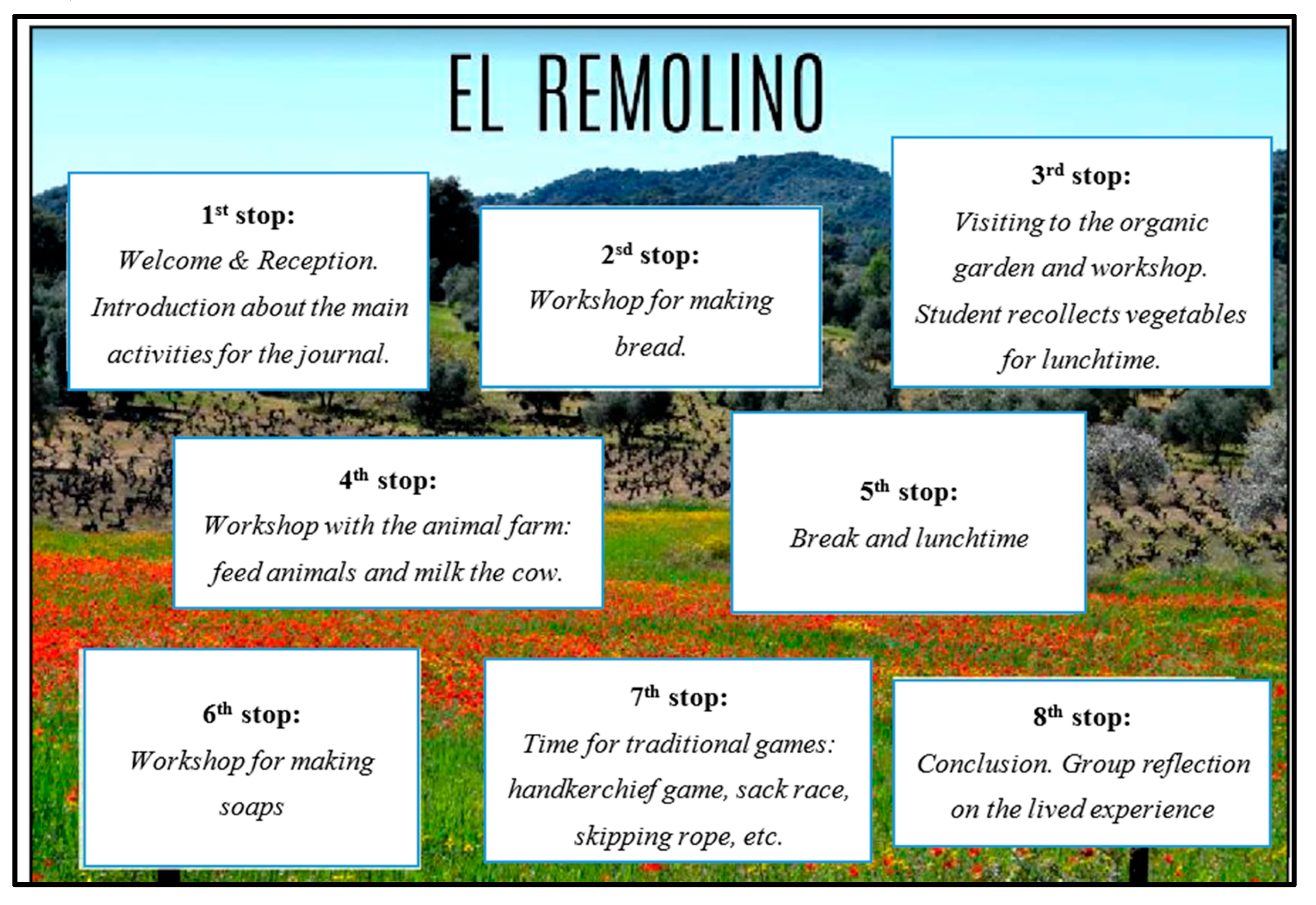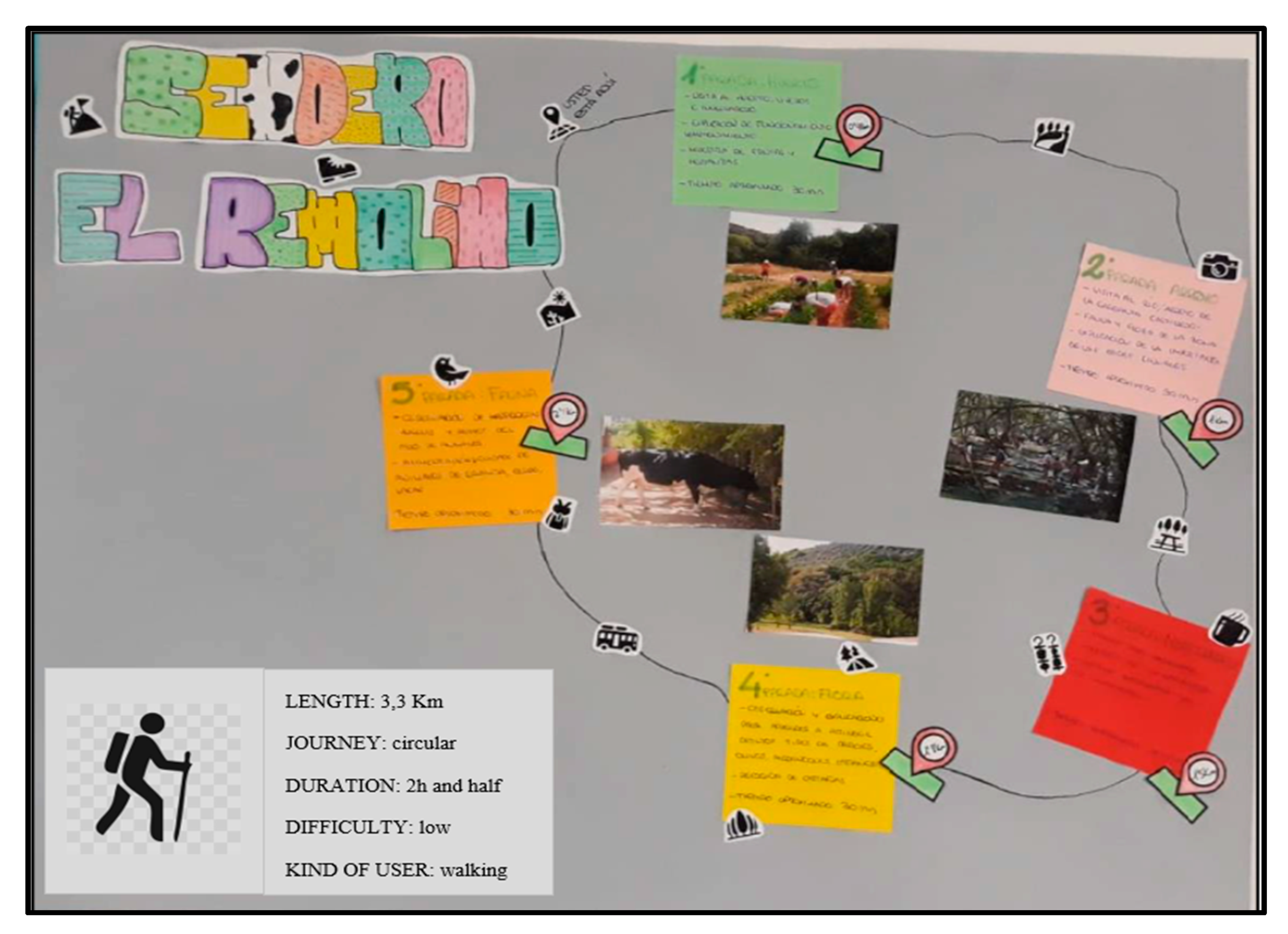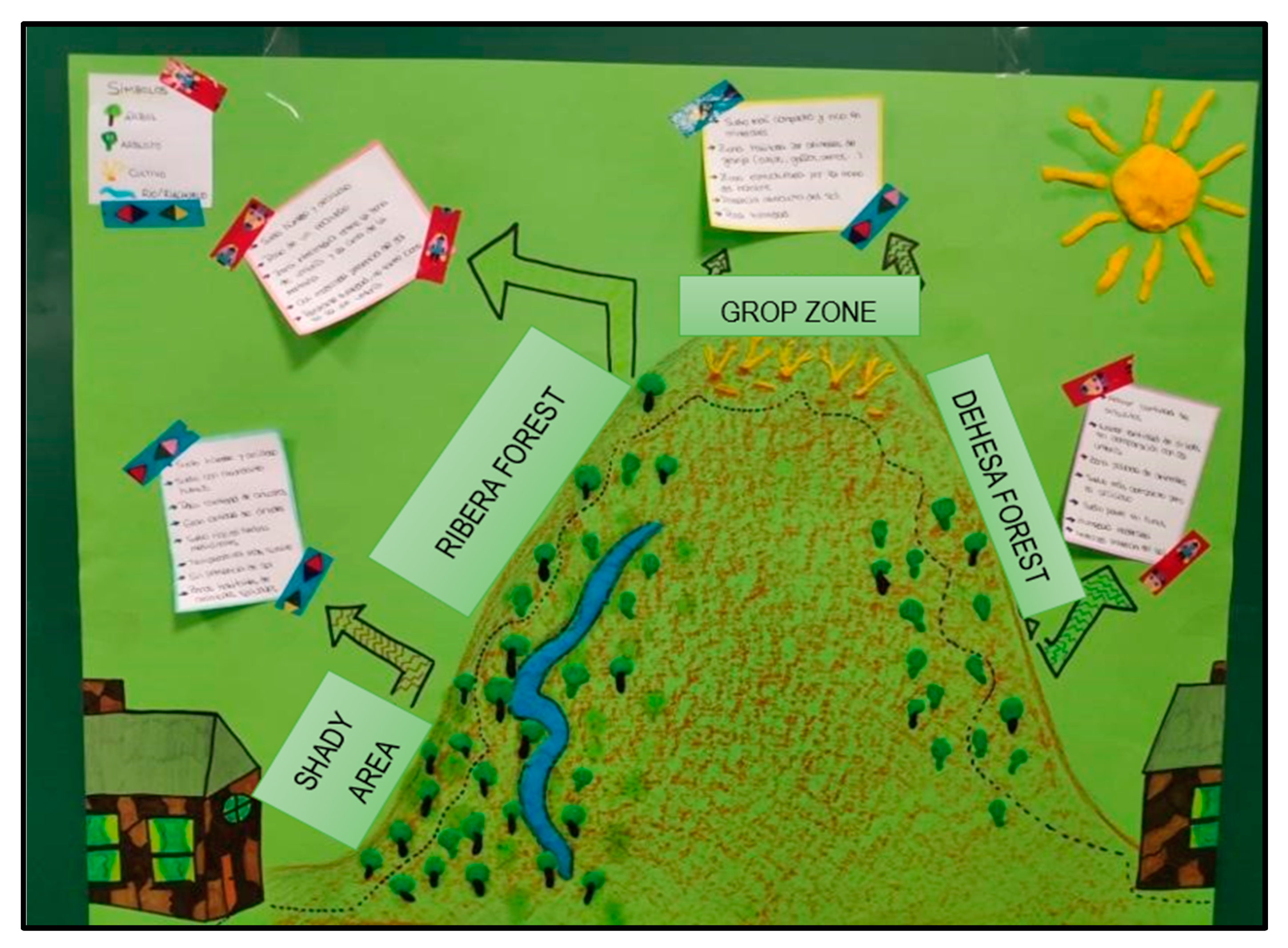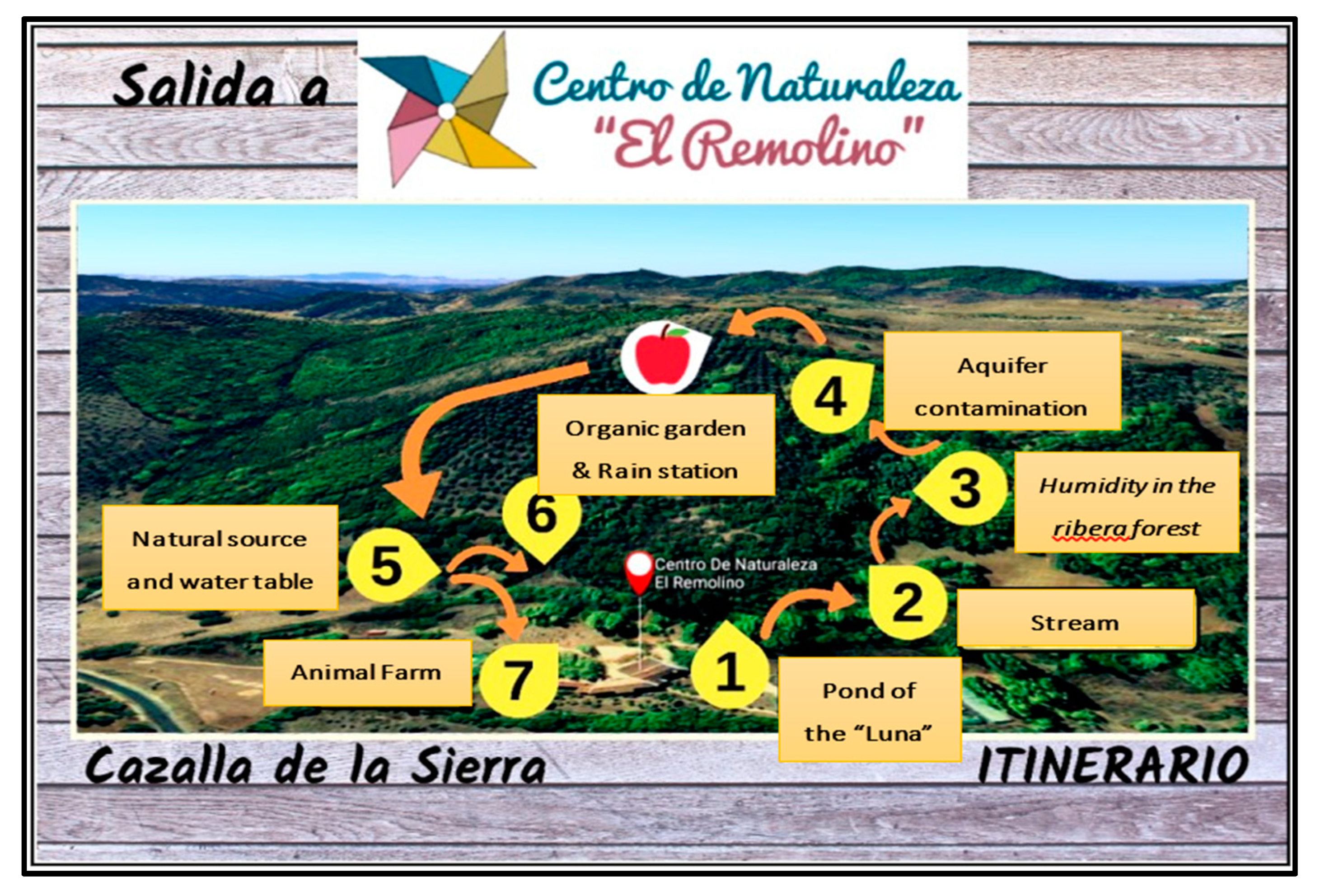An Approach to Prospective Primary School Teachers’ Concept of Environment and Biodiversity through their Design of Educational Itineraries: Validation of an Evaluation Rubric
Abstract
1. Introduction
2. Theoretical Framework
2.1. Biodiversity: A Challenge for Its Understanding and Construction in School
2.2. Outdoor Education and Their Interest for Teacher Training
2.3. Educational Itineraries: Conceptualization and Educational Opportunities for Science Education
3. Materials and Methods
3.1. Research Questions
- Main question. After an outdoor learning experience in a socio-natural environment close to their future pupils, what type of EI prospective primary education teachers design?
- Sub-questions:
- -
- Assessment using the rubric. Bearing in mind that there are no previous referents that propose instruments with which to value and evaluate educational itineraries, how can these designs be evaluated objectively and systematically?
- -
- Biodiversity learning and educational needs. As teacher educators, what are the main educational needs and learning difficulties about the biodiversity and its teaching in order to enhance the primary teacher’s formation?
3.2. Participants and the Teaching Proposal Context
- Phase 1. Before the field trip some aspects related to the area to be visited were studied in class: its geographical location, its most representative sociocultural, biological and geological characteristics, and any previous ideas the students had about it (Table 1). To collect the prior knowledge we did several activities: a brainstorming and debate (asking about main place´ features to visit); from different pictures (vegetation, villages, animals) belonging to the place to visit (trying to recognize the image); and with a blank map to assess if they could locate the area on the map. Finally, the students were divided into groups of 4–5 (a total of 28 groups) to plan the data collection process during the field trip.
- Phase 2. During the field trip a guided itinerary was carried out accompanied by nature-guides, in which the students took notes based on the observation and analysis of the territory. The length of the itinerary is about 3,3 Km and its duration was two hours and a half. Although it is possible to finish the route faster, we did some breaks and some stops to collect data and ask questions. In relation to the difficulty of the route is low and there is no possible risk during the whole it. The chosen area corresponded to a part of an old rural road of the Ruta de la Plata, a roadway configured in times of the Roman Empire, and used, for example, by the Carthusian monks during the 15th century. From the geological point of view, this territory is located on the margins of the Sierra Morena, made up of a broken relief of Precambrian rocks in contact with sedimentary materials from the Quaternary. The result is a morphology of mountain ranges, hills, and crags, cut through by embedded valleys that drain towards the Baetic Depression [51]. The path taken is within this geomorphological context. It is circular, first climbing and then descending the side of a hill. Thus, different environments and more or less human-modified ecosystems can be observed—from a valley crossed by a stream and its corresponding gallery forest, to widely varied hill vegetation (olive groves, chestnut woods, and cork and holm oak dehesas) combined with cropland and pastureland for free-ranging cattle, swine, and sheep. During this route, the students made an inventory of the resources or possible socio-natural elements that the place offers, to later design the stops that make up the EI.
- Phase 3. Finally, after the outdoor experience, the field data were shared and analysed in the classroom by future teachers. In this way, students build together the knowledge about the visited place. Finally, they designed the EIs about the visited place. Every group of students selected a theme (educational content) which will be the central topic of the activities of the itinerary. Likewise, they chose the best way to represent their itineraries. For this last part, we carry on a workshop about how to create an EI, its main features, and some examples of EI (imagens). During the workshop, we tried not to restrict the students ‘creativity and just some guidelines were provided to design their IE.
3.3. Data Sources and Procedure
4. Results
4.1. Formal Aspects
4.2. Teaching Aspects
5. Discussion
6. Conclusions
7. Limitations of the Study
Author Contributions
Funding
Conflicts of Interest
References
- Pedrinaci, E.; García de la Torre, E.; Sequeiros, L. El trabajo de campo y el aprendizaje de la Geología. Alambique Didáct. Cienc. Exp. 1994, 2, 37–46. [Google Scholar]
- Fernández-Ferrer, G.; González-García, F. Salidas de campo y desarrollo competencial. Enseñ. Cienc. Tierra 2017, 25, 295–301. Available online: https://www.raco.cat/index.php/ECT/article/view/330134/420944 (accessed on 20 June 2020).
- Morón, H.; Hamed, S.; Morón, M.C. ¿Cómo usan los futuros maestros de ciencias el medio socio-natural en el diseño de Itinerarios didácticos?: Algunos resultados y obstáculos de aprendizaje. In Investigación, Innovación Docente y TIC. Nuevos Horizontes Educativos; Alonso, S., Romero, J.M., Rodríguez-Jiménez, C., Sola, J.M., Eds.; Dykinson: Madrid, Spain, 2019; pp. 1754–1768. [Google Scholar]
- Loynes, C.; Michie, D.; Smith, C. Justifying outdoor education in the formal and informal curriculum. In A Guide for Outdoor Educators in Scotland; Higgins, P., Loynes, C., Crowther, N., Eds.; Adventure Education: Penrith, UK, 1997; pp. 15–21. [Google Scholar]
- Lee, H.; Stern, M.J.; Powell, R.B. Do pre-visit preparation and post-visit activities improve student outcomes on field trips? Environ. Educ. Res. 2020, 26, 989–1007. [Google Scholar] [CrossRef]
- Orion, N.; Hofstein, A. Factors that influence learning during a scientific field trip in a natural environment. J. Res. Sci. Teach. 1994, 31, 1097–1119. [Google Scholar] [CrossRef]
- Coll, S.D.; Coll, R.; Treagust, D. Making the most of out-of–school visits: How does the teacher prepare? Part I: Development of the Learner Integrated Field Trip Inventory (LIFTI). Int. J. Innov. Sci. Math. Educ. 2018, 26, 1–19. Available online: https://pdfs.semanticscholar.org/bde7/456d7db684a5179102c9bfd0e5d6a82c8424.pdf?_ga=2.156767099.1952557652.1592839419-812402438.1592839419 (accessed on 18 June 2020).
- Patrick, P.; Mathews, C.; Tunnicliffe, S.D. Using a field trip inventory to determine if listening to elementary school students’ conversations, while on a zoo field trip, enhances preservice teachers’ abilities to plan zoo field trips. Int. J. Sci. Educ. 2013, 35, 2645–2669. [Google Scholar] [CrossRef]
- Barnes, C.J. Preparing preservice teachers to teach in a culturally responsive way. Negro Educ. Rev. 2006, 57, 85–100. Available online: http://citeseerx.ist.psu.edu/viewdoc/download?doi=10.1.1.458.3111&rep=rep1&type=pdf (accessed on 17 June 2020).
- Díaz, M. Distribución del arbolado y persistencia a largo plazo de las dehesas: Patrones y procesos. Rev. Ecosistemas 2014, 23, 5–12. [Google Scholar] [CrossRef]
- Harlen, W. (Ed.) Principles and Big Ideas of Science Education; Association for Science Education: Hatfield, UK, 2010; Available online: https://www.ase.org.uk/bigideas (accessed on 2 February 2020).
- Bermúdez, G.M.A.; De Longhi, A.L.; Gavidia, V. El tratamiento de los bienes y servicios que aporta la biodiversidad en manuales de la educación secundaria española: Un estudio epistemológico. Rev. Eureka Sobre Enseñanza Divulg. Cienc. 2016, 13, 527–543. Available online: http://hdl.handle.net/10498/18495 (accessed on 10 March 2020).
- García Gómez, J.; Martínez, F.J. Cómo y qué enseñar de la biodiversidad en la alfabetización científica. Enseñ. Cienc. Rev. Investig. Exp. Didáct. 2020, 28, 175–184. Available online: https://www.raco.cat/index.php/Ensenanza/article/view/199611/353385 (accessed on 28 January 2020).
- Caurín, A.; Martínez, M.J. Análisis del concepto de biodiversidad en los libros de texto de segundo ciclo de primaria en la Comunidad Valenciana (España). Perf. Educ. 2013, 35, 97–114. [Google Scholar] [CrossRef]
- Schneiderhan-Opel, J.; Bogner, F.X. Between Environmental Utilization and Protection: Adolescent Conceptions of Biodiversity. Sustainability 2019, 11, 4517. [Google Scholar] [CrossRef]
- Rubio, J.M. Biogeografía. Paisajes Vegetales y Vida Animal; Síntesis: Madrid, Spain, 1988. [Google Scholar]
- Costa, J.C.; Martín, A.; Fernández, R.; Estirado, M. Dehesas de Andalucía. Caracterización Ambiental; Consejería de Medio Ambiente (Junta de Andalucía): Sevilla, Spain, 2006; Available online: https://www.juntadeandalucia.es/medioambiente/portal_web/web/servicios/centro_de_documentacion_y_biblioteca/fondo_editorial_digital/documentos_tecnicos/dehesas_andaluzas/dehesas_andaluzas.pdf (accessed on 27 February 2020).
- Ojeda, J.F.; Silva, R. Dehesas de Sierra Morena y políticas agroambientales comunitarias. Estud. Geogr. 1997, 57, 203–226. [Google Scholar] [CrossRef]
- Morón, H.; Morón, M.C. ¿Educación Patrimonial o Educación Ambiental? Perspectivas que convergen para la enseñanza de las ciencias. Rev. Eureka Sobre Enseñ. Divulg. Cienc. 2017, 14, 244–257. [Google Scholar] [CrossRef]
- National Research Council. Assessing 21st Century Skills: Summary of a Workshop; The National Academies Press: Washington, DC, USA, 2011. [Google Scholar]
- Rocard, M.; Csermely, P.; Jorde, D.; Lenzen, D.; Walwerg Henriksson, H.; Hemmo, V. Informe Rocard—Enseñanza de las Ciencias Ahora: Una Nueva Pedagogía para el Futuro de Europa; European Comission: Brussels, Belgium, 2007. [Google Scholar]
- COSCE. Informe Enciende: Enseñanza de las Ciencias en la Didáctica Escolar para Edades Tempranas en España; Rubes Editorial: Madrid, Spain, 2011; Available online: https://www.cosce.org/pdf/Informe_ENCIENDE.pdf (accessed on 10 January 2020).
- Organic Law 8/2013, 9 December, for the Improvement of Educational Quality; Ministerio de la Presidencia (Boletín Oficial del Estado, 295): Madrid, Spain, 2013; pp. 97858–97921. Available online: https://www.boe.es/boe/dias/2013/12/10/pdfs/BOE-A-2013-12886.pdf (accessed on 16 January 2020).
- Order 17 March 2015, por la que se Desarrolla el Currículo Correspondiente a la Educación Primaria en Andalucía; Consejería de Educación de la Junta de Andalucía (Boletín Oficial de la Junta de Andalucía, 60): Sevilla, Spain, 2015; pp. 9–696. Available online: https://www.juntadeandalucia.es/boja/2015/60/1 (accessed on 30 January 2010).
- Souto, X.M. El espacio cotidiano como objeto de aprendizaje en las primeras edades escolares (3–8 años). In Didáctica de la Geografía. Problemas Sociales y Conocimiento del Medio; Souto, X.M., Ed.; Del Serbal: Barcelona, Spain, 1998; pp. 221–241. [Google Scholar]
- Vilarrasa, A. Salir del aula. Reapropiarse del contexto. Íber. Didáct. Cienc. Soc. Geogr. Hist. 2006, 9, 13–25. [Google Scholar]
- Romero-Ariza, M. El aprendizaje por indagación: ¿existen suficientes evidencias sobre sus beneficios en la enseñanza de las ciencias? Rev. Eureka Sobre Enseñ. Divulg. Cienc. 2017, 14, 286–299. [Google Scholar] [CrossRef]
- Couso, D. De la moda de “aprender indagando” a la indagación para modelizar: Una reflexión crítica. In Investigación y Transferencia para una Educación en Ciencias: Un Reto Emocionante; Heras, M.A., Lorca, A., Vázquez, B., Wamba, A., Jiménez, R., Eds.; Servicio de Publicaciones Universidad de Huelva: Huelva, Spain, 2014; pp. 1–28. [Google Scholar]
- Blanca, S.; Hidalgo, J.; Burgos, C. Escuela infantil y ciencia: La indagación científica para entender la realidad circundante. Enseñ. Cienc. Rev. Investig. Exp. Didáct. 2013, 979–983. Available online: https://www.raco.cat/index.php/Ensenanza/article/view/295136/383783 (accessed on 16 June 2020).
- Lederman, N.G.; Lederman, J.S.; Antink, A. Nature of science and scientific inquiry as contexts for the learning of science and achievement of scientific literacy. Int. J. Educ. Math. Sci. Technol. 2013, 1, 138–147. Available online: https://files.eric.ed.gov/fulltext/ED543992.pdf (accessed on 19 June 2020).
- Garritz, A. Naturaleza de la ciencia e indagación: Cuestiones fundamentales para la educación científica del ciudadano. Rev. Iberoam. Educ. 2006, 42, 127–152. Available online: https://rieoei.org/historico/documentos/rie42a07.pdf (accessed on 16 June 2020).
- Abd-el Khalik, F.; BouJaoude, S.; Duschl, R.; Lederman, N.G.; Mamlok Naaman, R.; Hofstein, A.; Niaz, M.; Treagust, D.; Tuan, L. Inquiry in science education: International perspectives. Sci. Educ. 2004, 88, 397–419. [Google Scholar] [CrossRef]
- Zamalloa, T.; Sanz, J.; Maguregi, G.; Fernández, L.; Echevarría, I. Acercar la geodiversidad a través de las salidas de campo en la ESO. Una investigación con el profesorado de ciencias de Bizkaia. Enseñ. Cienc. Rev. Investig. Exp. Didáct. 2014, 32, 443–467. [Google Scholar] [CrossRef][Green Version]
- Morales, A.J.; Caurín, C.; Sendra, C.; Parra, M. Aprendiendo a plantear problemas en el medio. Análisis de una experiencia con estudiantes del Máster de Investigación en Didácticas. Didáct. Cienc. Exp. Soc. 2014, 28, 68–81. [Google Scholar] [CrossRef]
- Tal, R.T.; Morag, O. Refective practice as a means for preparing to teach outdoors in ecological garden. J. Sci. Teach. Educ. 2009, 20, 245–262. [Google Scholar] [CrossRef]
- Amórtegui, E.; Mayoral, O.; Gavidia, V. Aportaciones de las Prácticas de Campo en la formación del profesorado de Biología: Un problema de investigación y una revisión documental. Didáct. Cienc. Exp. Soc. 2017, 32, 153–170. [Google Scholar] [CrossRef]
- Costillo, E.; Borrachero, A.B.; Villalobos, A.M.; Mellado, V.; Sánchez, J. Utilización de la modelización para trabajar salidas al medio natural en profesores en formación de educación secundaria. Bio-Grafía Escr. Sobre Biol. Enseñ. 2014, 7, 165–175. Available online: https://revistas.pedagogica.edu.co/index.php/bio-grafia/article/view/3000 (accessed on 3 February 2020).
- Preston, L. Making connections with nature: Bridging the theory—Practice gap in outdoor and environmental education. J. Outdoor Environ. Educ. 2004, 8, 12–19. [Google Scholar] [CrossRef]
- Toro, F.J.; Garrido, J.; Hernández, R. “Vuelta a la naturaleza”: La enseñanza de la Geografía y el trabajo de campo según los principios de la escuela moderna. In La Reconfiguración del Medio Rural en la Sociedad de la Información. Nuevos Desafíos en la Educación Geográfica; Macía, X., Armas, F., Rodríguez, F., Eds.; Andavira: Santiago de Compostela, Spain, 2019; pp. 1351–1360. [Google Scholar]
- Collado, S.; Corraliza, J.A. Conciencia Ecológica y Bienestar en la Infancia. Efectos de la Relación con la Naturaleza; CCS: Madrid, Spain, 2016. [Google Scholar]
- Boyle, A.; Conchie, S.; Maguire, S.; Martin, A.; Milsom, C.; Nash, R.; Rawlinson, S.; Turner, A.; Wurthmann, S. Fieldwork is Good: The Student Perception and the Affective Domain. J. Geogr. High Educ. 2007, 31, 299–317. [Google Scholar] [CrossRef]
- Mateo, M.R. Las salidas de campo en el medio rural. Análisis de las investigaciones presentadas a congresos del grupo de trabajo de didáctica de la geografía de la AGE y de la APG (1988–2016). In La Reconfiguración del Medio Rural en la Sociedad de la Información. Nuevos Desafíos en la Educación Geográfica; Macía, X., Armas, F., Rodríguez, F., Eds.; Andavira: Santiago de Compostela, Spain, 2019; pp. 1279–1292. [Google Scholar]
- Sanmartí, N. Didáctica de las Ciencias en la Educación Secundaria Obligatoria; Síntesis: Madrid, Spain, 2002. [Google Scholar]
- Aguilera, D. La salida de campo como recurso didáctico para enseñar ciencias. Una revisión sistemática. Rev. Eureka Sobre Enseñ. Divulg. Cienc. 2018, 15, 3103–3117. [Google Scholar] [CrossRef]
- Jerez, O. La transferencia de conocimientos didácticos-geográficos en el medio rural. El senderismo didáctico como propuesta para un desarrollo rural sostenible. In La Reconfiguración del Medio Rural en la Sociedad de la Información. Nuevos Desafíos en la Educación Geográfica; Macía, X., Armas, F., Rodríguez, F., Eds.; Andavira: Santiago de Compostela, Spain, 2019; pp. 1321–1333. [Google Scholar]
- Guerra, F.J. Guías Prácticas Voluntariado Ambiental. Diseño de Itinerarios en el Medio Natural; Consejería de Medio Ambiente (Junta de Andalucía): Seville, Spain, 2010. [Google Scholar]
- Olave, D. El itinerario didáctico: Una propuesta metodológica para el análisis geo-histórico local. Geoenseñanza 2005, 10, 197–208. Available online: https://www.redalyc.org/pdf/360/36010206.pdf (accessed on 30 March 2020).
- Liceras, Á. Los itinerarios didácticos en la enseñanza de la geografía. Reflexiones y propuestas acerca de su eficacia en educación. Rev. Unes. Univ. Esc. Soc. 2018, 5, 66–81. Available online: https://www.revistaunes.com/index.php/revistaunes/article/view/64/52 (accessed on 14 January 2020).
- Alcántara, J.; Medina, S.M. El uso de los itinerarios didácticos (SIG) en la educación ambiental. Enseñ. Cienc. Rev. Investig. Exp. Didáct. 2019, 37, 173–188. [Google Scholar] [CrossRef]
- Caamaño, A. Los trabajos prácticos en ciencia. In Enseñar Ciencias; Jiménez, M.P., Ed.; Barcelona: Barcelona, Spain, 2003; pp. 95–118. [Google Scholar]
- Mata-Olmo, R.; Sanz-Herráiz, C. Los paisajes de Andalucía. In Geografía de Andalucía; López Ontiveros, A., Ed.; Ariel: Barcelona, Spain, 2003; pp. 847–878. [Google Scholar]
- Porlán, R.; Azcárate, P.; Martín, R.; Rivero, A. Conocimiento profesional deseable y profesores innovadores: Fundamentos y principios formativos. Investig. ESC 1996, 29, 23–38. Available online: https://revistascientificas.us.es/index.php/IE/article/view/8088/7147 (accessed on 3 February 2020).
- Alonzo, A.C. Exploring the learning progression–formative assessment hypothesis. Appl. Meas. Educ. 2018, 31, 101–103. [Google Scholar] [CrossRef]
- Gunckel, K.L.; Covitt, B.A.; Salinas, I.; Anderson, C.W. A learning progression for water in socio-ecological systems. J. Res. Sci. Teach. 2012, 49, 843–868. [Google Scholar] [CrossRef]
- Creswell, J.W.; Poth, C.N. Qualitative Inquiry and Research Design: Choosing among Five Approaches; Sage Publications: London, UK, 2016. [Google Scholar]
- Cruz-Guzmán, M.; Puig Gutiérrez, M.; García-Carmona, A. ¿Qué tipos de actividades diseñan e implementan en el aula futuros docentes de Educación Infantil cuando enseñan ciencia mediante rincones de trabajo? Enseñ. Cienc. 2020, 38, 27–45. [Google Scholar] [CrossRef]
- Astolfi, J.P. El “Error”, un Medio para Enseñar; Díada: Seville, Spain, 1999. [Google Scholar]
- García, J.E. Una hipótesis de progresión sobre los modelos de desarrollo en Educación Ambiental. Investig. ESC 1999, 37, 15–27. Available online: https://revistascientificas.us.es/index.php/IE/article/view/7840/6939 (accessed on 5 March 2020).
- García, J.E. Educación Ambiental, Constructivismo y Complejidad; Díada: Seville, Spain, 2004. [Google Scholar]
- Morón, H.; Wamba, A.M. La percepción sobre los riesgos ambientales como indicador de los obstáculos y dificultades para la construcción de un concepto de medio ambiente responsable. Bio-Grafía Escr. Sobre Biol. Enseñ. 2010, 3, 114–137. [Google Scholar] [CrossRef]
- García Gajardo, F.; Fonseca, G.; Concha, L. Aprendizaje y rendimiento académico en educación superior: Un estudio comparado. Rev. Electrón. Actual Investig. Educ. 2015, 15, 1–26. Available online: https://www.redalyc.org/pdf/447/44741347019.pdf (accessed on 22 February 2020).
- De-Juanas Oliva, A.; Martín Del Pozo, R.; González Ballesteros, M. Competencias docentes para desarrollar la competencia científica en educación primaria. Bordón 2016, 68, 103–120. [Google Scholar] [CrossRef]
- Van Weelie, D. Making biodiversity meaningful through environmental education. Int. J. Sci. Educ. 2002, 24, 1143–1156. [Google Scholar] [CrossRef]
- Grace, M. Developing high quality decision-making discussions about biological conservation in a normal classroom setting. Int. J. Sci. Educ. 2009, 31, 551–570. [Google Scholar] [CrossRef]
- López de Haro, L.; Segura-Serrano, J.A. Los itinerarios didácticos: Un recurso interdisciplinar y vertebrador del curriculum. Espiral. Cuad. Profr. 2013, 6, 15–31. [Google Scholar] [CrossRef]
- Palacios Mena, N.; Ramiro Roca, E. El aprendizaje de las ciencias sociales desde el entorno: Las percepciones de futuros maestros en el Geoforo Iberoamericano de Educación. Rev. Bibliogr. Geogr. Cienc. Soc. 2017, 22, 1–22. Available online: https://revistes.ub.edu/index.php/b3w/article/view/26431/27846 (accessed on 2 April 2020).
- Dal Ré Carneiro, C.; Wagner, P. Actividades de campo en la asignatura Ciencia del Sistema Tierra: La Geología como estructura básica. Enseñ. Cienc. Tierra 2011, 19, 48–56. Available online: https://www.raco.cat/index.php/ECT/article/view/244378/331350 (accessed on 10 April 2020).







| Some Examples |
|---|
|
| (A) | |||
|---|---|---|---|
| CATEGORIES | LEVELS | ||
| I | II | III | |
| 1. Type of itinerary | The sense and direction of the path is undefined (where it begins, ends or continues). | That of linear type. The path is well defined with a beginning and end. | The one of circular type (selects all the territory visited): starts where it ends. |
| 2. Number of stops | Low number of stops represented (4 or less); or they are too many and little operative or irrelevant. | It has a sufficient number of stops for the route it designs (between 5–6). | It has an optimal number of stops from an educational point of view (between 7–8). |
| 3. Location and representation | No location and no representation-does not establish geographic links for selected items. Design a route, but without representing the stops / activities at specific geographic points and without making a geographical representation of the place. You have not completed a route. | Location, but without geographic representation. It locates the most outstanding elements of the path in specific points, but they are decontextualized, because the place is not geographically represented. | Location or partial or complete geographical representation. It locates and contextually represents the most outstanding elements of the path, including biological, geological and geographic aspects, from a systemic perspective of the environment. |
| (B) | |||
| CATEGORIES | LEVELS | ||
| I | II | III | |
| 4. Theme | Without integration: It does not have an explicit theme or theme thread, since there is no clear educational link between the elements used on the path. | It has a theme, but without being explicit or having, a clear educational purpose among the elements used as a teaching resource; or the educational objective of the itinerary is not related to the selected element. Disconnection of the milestones of the stops. | It has an explicitly defined theme that connects all the different elements observed along the route, based on one or more educational objectives. |
| 5. Socio-natural elements | Collect, as teaching resources, flora (trees, shrubs or plants), fauna (wild or farm animals), geological elements (water from rivers, streams or ponds; soil; rocks; etc.), materials anthropic (infrastructures, wells, bridges, houses, farms, mills, etc.), but without establishing relationships or links between them. | Mainly uses physical-chemical and perceptual-sensory elements (humidity, thermal sensation, sounds of animals or the environment, colors, textures) to make the stops on the itinerary. It uses natural (geological or biological) or human elements. | It gathers, as teaching resources, environmental elements that use and interrelate different physiological elements (biological, geological and human: landscapes, places, spaces, etc.), connecting them geographically with the place. |
| 6. Designed activities | Activities are designed without a clear educational intention, or oriented to recess and leisure: dynamics or games to promote confidence, perform some physical activity, stops to rest or eat, etc. Or decontextualized activities are designed with the resources and elements of the medium. | The activities have an educational intent, but are mainly traditional in nature; Little or nothing interactive with the place, they do not promote the exploration of the place or the development of scientific skills: expository or informative talks, free observation, contemplation of the landscape, etc. | The activities have an educational intent, predominantly those of an interactive nature with the environment (games, exploration, directed observation, collection of elements / data from the environment, etc.), and promoting the development of scientific skills with contextualized learning. |
| Selected Theme |
|---|
| Healthy habits. |
| Designed activities |
|
| Selected Theme |
| Unspecified. |
| Designed activities |
|
© 2020 by the authors. Licensee MDPI, Basel, Switzerland. This article is an open access article distributed under the terms and conditions of the Creative Commons Attribution (CC BY) license (http://creativecommons.org/licenses/by/4.0/).
Share and Cite
Morón-Monge, H.; Morón-Monge, M.d.C.; Abril-López, D.; Daza Navarro, M.P. An Approach to Prospective Primary School Teachers’ Concept of Environment and Biodiversity through their Design of Educational Itineraries: Validation of an Evaluation Rubric. Sustainability 2020, 12, 5553. https://doi.org/10.3390/su12145553
Morón-Monge H, Morón-Monge MdC, Abril-López D, Daza Navarro MP. An Approach to Prospective Primary School Teachers’ Concept of Environment and Biodiversity through their Design of Educational Itineraries: Validation of an Evaluation Rubric. Sustainability. 2020; 12(14):5553. https://doi.org/10.3390/su12145553
Chicago/Turabian StyleMorón-Monge, Hortensia, María del Carmen Morón-Monge, Daniel Abril-López, and María Paula Daza Navarro. 2020. "An Approach to Prospective Primary School Teachers’ Concept of Environment and Biodiversity through their Design of Educational Itineraries: Validation of an Evaluation Rubric" Sustainability 12, no. 14: 5553. https://doi.org/10.3390/su12145553
APA StyleMorón-Monge, H., Morón-Monge, M. d. C., Abril-López, D., & Daza Navarro, M. P. (2020). An Approach to Prospective Primary School Teachers’ Concept of Environment and Biodiversity through their Design of Educational Itineraries: Validation of an Evaluation Rubric. Sustainability, 12(14), 5553. https://doi.org/10.3390/su12145553






